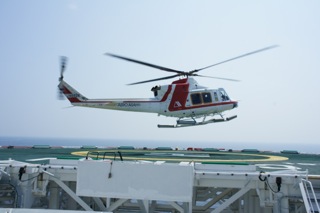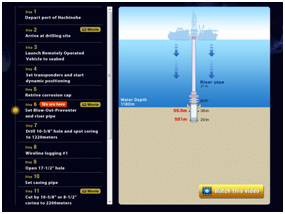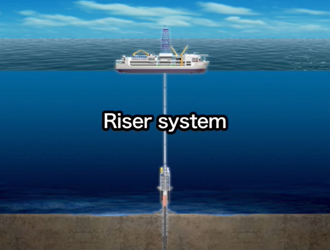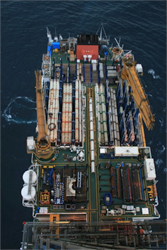

From Macro to MicroAugust 14, 2012
On the helideck at 12am, we kicked off the night shift gazing deep into enveloping darkness, eyes keenly tuned to shooting stars. Yesterday morning was the Perseid meteor shower. Beyond the lighted derrick, and above a thin veneer of fog, the sky revealed a pristine clarity. While the early hours afforded us a few spectacular meteor sightings, the tireless heavy morning fog steadily settled in.
We retreated to the lab where the scientists anxiously continue preparation for the long-anticipated arrival of the first ocean sediments. For some the research has yet to begin, for me it already has. This site has been drilled once before - during the CK06-06 Shakedown Cruise in 2006. The first approximately 600 meters of ocean floor were drilled then, but only the upper 350 meters recovered - that’s what I’m looking at.
My specialty is micropaleontology. I am particularly interested in diatoms (single-celled siliceous phytoplankton) and calcareous nannofossils (single-celled calcareous phytoplankton), the biostratigraphic records of which apply precise geological ages to ocean sediments. They are both exceedingly useful for telling the story of paleoenvironmental shifts within the oceans, as well.
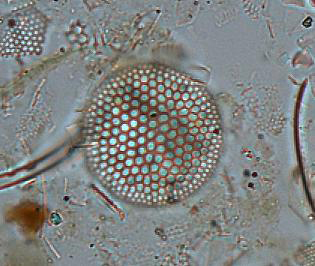
Thalassiosira oestrupii is a marine diatom and marker species used to date sediments up to 5.5 millions years old.
What takes hundreds of meters of drilling pipe to recover requires hundreds of times of magnification to identify. A trained eye and patience goes a long way in this sport, too! Within the upper 350 meters, I am working to refine the existing age model of oceanic sediments at this site based on particular species called “marker species”.
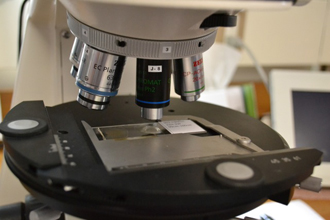
A polarizing microscope prepared to observe diatoms and calcareous nannofossils prepared from drilled sediments.
The first and last appearances of these so-called “marker species” must correlate across vast regions, if not globally, in order to be reliable markers of time. They tend also to be common in their occurrence and distinctive in appearance. Alongside with geologic time, I will look more closely at entire assemblages of these microfossils to articulate the paleoenvironments that supported them - after all, history repeats itself and if we know where we came from, we can see where we are headed.
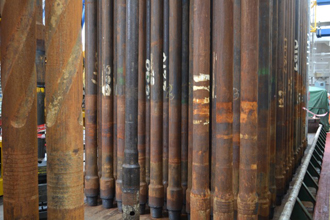
The necessary "macro" for retrieving ocean sediments.


Wonderful Days on the ChikyuAugust 13, 2012
I am finally being on board the Chikyu as a shipboard sedimentology scientist! I am very happy that my dream of working on the Chikyu comes true.
The Kochi University that is my current working place has a facility of IODP core repository, so that we University peoples have a very close relationship with IODP and scientific ocean drilling. In fact, I have had some chances to visit the Chikyu while she comes to the port of Kochi. Also, this cruise was once postponed over 1 year ago because the Chikyu was damaged by the gigantic earthquake in Tohoku area off Japan, which was 4 days before the departure. So, it is such a pleasure finally to join this expedition.
The Chikyu can accommodate a total of 200 boarding persons, including ~30 scientists, ~20 technical experts and over 100 ship crews and drillers. All of us are working all day, 12 hours x 2, day-shift and night-shift, which is amazing. A good thing (to me) is... we have 4 meal times in a day, featuring various foods in buffet-style. I am really enjoying eating such delicious foods every day, with fruits and sweets and soft drinks (non-alcoholic :P) …well, what I have to be careful should be not to become overweight by eating too much :D
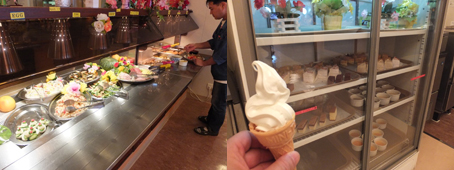
Delicious foods and sweets in buffet style, attempting me, always...
The life on the Chikyu will be for 2 months in the isolated place. Sometimes, I visit the helideck to be refreshed, quite place with nice ocean view and sunlight. I also often spend time in the gym, sauna and jacuzzi.
I am one of the elder scientists, but still young spirit as a scientist!, but here the team consists of many young scientists with extremely high spirits on board. So, our cruise is fully filled with energy. When I was 30 years old, I sailed on the JOIDES Resolution for the ODP cruise in the Atlantic Ocean. Now is my second experience to be on the scientific drill ship, and I am going to work equally as hard as the young scientists (Yeah!). As to me on the Chikyu, I hope you are also waiting for our challenging and successful results from Expedition 337!

Gym, sauna and jacuzzi in the accommodation area on the Chikyu.
Good for relaxing and health after hard work.


BOP Landed Successfully!August 12, 2012
The blow-out-preventer (BOP) has been successfully landed on the wellhead at 21:30p.m. last night!! (See the entry of Aug 8. for introduction to the BOP)
This is more than a small step, but a giant leap toward the start of riser drilling. It was Aug 7 when the BOP was first lowered into the sea. Since then, every part and function has been tested before the landing. Science party is quite impressed with the patient, professional work of engineers who made all those work to confirm everything of such a huge, complicated equipment and to solve each tiny, potential issues one by one.
Since seafloor image from a remote operational vehicle (ROV) was displayed on the monitor, some of the scientists were glued to the monitor. But the BOP landing is a not a simple task. It is to land the equipment of about 400 ton, connected at the toe of the pipe extending to the 1200 m below sea surface, exactly onto the wellhead. The only clue is ROV display, which is not very clear in the deep sea to control the position. We had to watch BOP moving above the wellhead slowly, and starting over from the start, many times. Knowing this, the scientists prepared drink and pop-corn to keep watching the patient work of engineers.
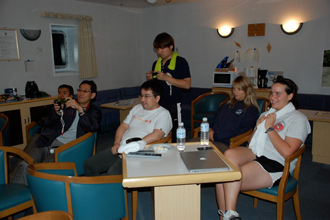
Scientists ready to celebrate the successful landing of BOP
After a while, the time has come. Everyone was ready to celebrate the successful entry to the wellhead. But... at the moment BOP contacted the wellhead, ROV image transmission was lost suddenly. But the engineers managed to continue the operation and when the ROV image recovered, we could confirm the landing was successful. Although we missed the best moment, we were glad that the mission was completed successfully.

(just before) the moment of landing, and lost transmission of ROV image. We confirmed successful landing soon after this.
Anyway, it was a big progress in the course of riser drilling, and we are approaching to the day we receive the first sample. Unfortunately we will not have core sample soon, because we had to cancel the coring operation in the shallow section. But we will soon get cuttings and mud gas samples recovered from the borehole. All of science party members are ready to take and analyze samples based on a new plan.


Gas MonitoringAugust 11, 2012
Good morning. Today, I will introduce the “mud gas monitoring” work. Four scientists, including me, will undertake this research onboard the Chikyu.
In this cruise, we will drill deep - down to 2,200 m below the seafloor - by using the riser drilling system. In this type of system, drilling mud is circulated to control the borehole pressure and to lubricate the drill bit. When the mud circulates, small fragments of sediments and water, or gas trapped in the sediment, are also carried to the ship. Four of us will monitor the change of chemical compositions in the sediments.
Once, I asked a drilling engineer, “Why do we call this Riser Drilling”. He answered, “The riser drilling system has been used for oil drilling. Circulating mud or oil rises along the pipes, so we call it Riser Drilling”. I got it. But in this expedition important scientific information will rise up instead of oil.
Natural gas is closely related to the microbial activity in the sub-seafloor. For example, it is known that there is a microbe that produces methane as a metabolic byproduct from hydrogen gas and carbon dioxide. We can detect high microbial activity by monitoring the chemical compositions of methane and other gases.
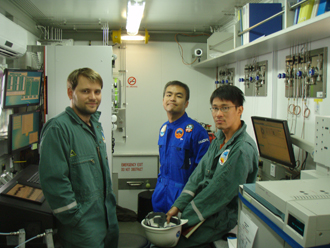
Marshal Bowles (He just arrived yesterday by a helicopter and joined as new member, Bremen University), me, and Wei-Li Hong (Oregon State University)
in the new gas-monitoring laboratory on the Chikyu.
Gas-monitoring laboratory is in a converted container near the derrick far from the ordinary laboratory area near the front. We will work in this lab on rotating shifts so we work 24 hours a day. In fact, this is the first run of the scientific gas monitoring system that was introduced last year on the Chikyu. The lab is crowded with new and shiny apparatuses waiting for the rocks to come up from the deep well. Of course, we are waiting for that with great expectation and anxiety. We in the gas monitoring team are really excited because we should be the first people to get new scientific data ahead of anybody else onboard just after the start of drilling!


There and Back AgainAugust 9, 2012
Der ‘blow-out-preventer’ (BOP) wurde heute durch den ‘Moonpool’ in das Meer gelassen und wir Wissenschaftler warten nun alle mit Vorfreude ungeduldig auf die ersten Proben. Dies ist meine erste Ausfahrt auf der ich das Riser Drilling erleben darf, obwohl es meine zweite Fahrt mit diesem Schiff ist.
The blow-out-preventer (BOP) was lowered down into the sea today and we, the impatient scientist, are all excited and anxious to get the first samples. This is the first time for me to experience Riser drilling, although it is my second time onboard the Chikyu.
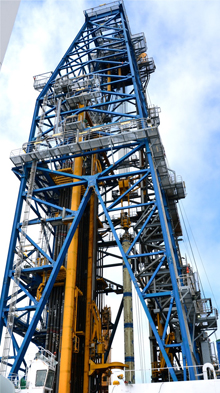
A riser pipe is standing on the drill floor that will be connected each one-by-one and lowered down into the deep sea.
In 2007 hatte ich bereits die Möglichkeit bei einer Expedition auf der Chikyu teilzunehmen (IODP Expedition 316). Damals war ich überwältigt von der Grösse und Ausstattung des Schiffes sowie beeindruckt von den Labor-Technikern. Ich erinnere mich noch, als ich die Labore zum ersten mal betrat und für mich dachte: ‘wow, jedes Labor in der Welt hätte bestimmt gerne so eine Ausstattung’.
When I sailed the first time in 2007 (IODP Expedition 316), together with Fumio Inagaki (our co-chief on this IODP 337 cruise), I was overwhelmed and impressed by the dimensions of the Chikyu, the lab facilities and the helpful lab technicians. I still remember when entering the labs for the first time I just thought “wow, I bet every lab in the world would love to have such equipment”.
Es gab so viele Messinstrumente auf kleinsten Raum - falls der Begriff ‘klein’ im Zusammenhang mit der Chikyu überhaupt anwendbar ist. Heute, fast 5 Jahre danach, hat die Chikyu und ihre Mannschaft es tatsächlich geschafft auch dies noch zu übertreffen: Noch mehr Geräte wurde angeschafft und Labor Methoden und Anwendungen wurde optimiert. Sogar der Erholungsraum wurde neu bestückt: die Tischtennisplatte hat einen kleinen Kicker Bruder bekommen. Diese Ausfahrt strebt einen neuen Tiefen-Rekord in der Bohrgeschichte der Wissenschaft an und ich bin überzeugt, mit diesem Schiff und seiner Mannschafft werden wir erfolgreich sein.
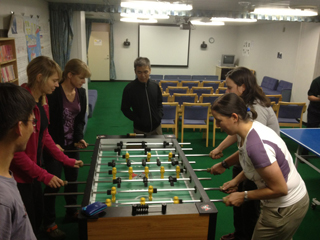
Scientists in the recreation room on the Chikyu.
The football match is exciting as the Olympic game in London.
There were so many state-of-the-art instruments combined in such a compressed work area. Today, almost 5 years later, the Chikyu and lab techs managed to even top that and it improved beyond imagination - Futureal. More instruments were added to the already amazing facilities, and lab techniques and procedures were optimized. Even the recreation room was upgraded: the ping-pong table now has a little football brother (yeah). This expedition is heading for the new depth-record in the scientific ocean drilling history and with this ship and crew I have no doubt that we will be successful.


The Blow-Out-Preventer (BOP) for the Chikyu riser drillingAugust 8, 2012
One of the major characteristics of the Chikyu is the riser-drilling system. The blow-out-preventer (BOP) plays an important functional role in the riser-drilling operation, which has functions that controls the pump pressure of circulation drilling mud, monitors/controls the borehole pressure, and prevents the potential explosion of deep natural gas or fluids. The weight of BOP is approximately 380 tons and the height is 14.5 meter (see the photo). The BOP is connected with the multiple riser pipes, which is also very large; a riser pipe is 27 meters in length and 50 cm in diameter. The riser pipe will be connected each one by one on the drill floor, landing the BOP on the well head at 1180 meters in water depth. If we set up the all BOP and riser pipes down to our target water depth, the total weight will be over 1000 tons!! Chikyu is big enough and enables to do it.
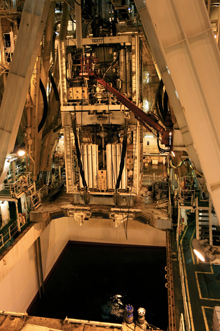
The blow-out-preventer (BOP) for the riser drilling is ready to go down from the moon pool on the Chikyu to the deep seabed.
After the departure from the port of Hachinohe, the drilling team on the Chikyu has been working very hard for the preparation of the BOP installation and running, for which all the safety and regulation tests such as pressure and control function are carried out on the ship. The preparation is crucial for all the planned operations. Because it is difficult to be done in the deep-sea, it needs to be completely done on the ship before we start drilling. Today, we have finally completed the preparations and pressure test and now I see the BOP connected to the bottom riser pipe is placed in the moon pool :-)
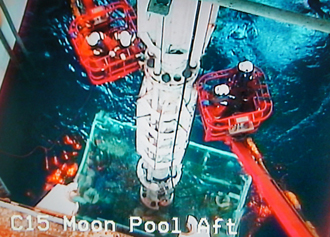
Due to the preparation, the current status is approximately 6 days-behind of the original operational plan. However, we will modify the drilling program by directly using 17-1/2 inch drill bit instead of 10-5/8 inch bit (see: operation sequences at http://www.jamstec.go.jp/chikyu/exp337/e/schedule.html), which will make the drilling speed much faster and recover several days.
Shipboard scientists are now almost ready and very much looking forward to having the samples on board. During the initial phase of drilling down to 1225 meter in depth, on-line/on-time geochemical analyses of the circulating mud-gas (natural gas) in the newly developed mud-gas geochemistry lab, as well as sedimentological, fossil-based paleontological, (bio-) geochemical and microbiological analyses of the drilling fluids and cuttings during the riser drilling, will be carried out. Most of these related to the riser drilling are in fact the first attempt in the scientific ocean drilling that has a half-century of the history.


A deep breath on top of the ChikyuAugust 6, 2012
Today we are exactly one week onboard of the Scientific Deep-Sea Drilling Vessel "Chikyu", which means "Earth" in Japanese. The scientists are getting used to the labyrinth-like interior of the ship and its pace of life. The measurement plan for each expertise group, ranging from microbiology to sedimentology, is as good as ready and we are almost done with setting up the various laboratories we will soon work in. You can definitely feel that everyone is very eager to start this more than 2200 meter below seafloor drilling adventure. A highly advanced technology, called the riser drilling system, will be used for the drilling. However, given the relatively sensitive preparations required for this technology, we are still waiting for every single piece of equipment involved in the system to be fully operational and safety checked. Safety first! The updates are optimistic and we believe we will soon be able to start the work.
In the meantime, the Chikyu knows many ways to surprise us. This afternoon, given the nice weather and the flatness of the sea, Chief HSE (Health, Safety & Environment) officer Dennis Noordijk makes us a favor to bring us on top of the derrick. The derrick is this 120-meter (from sea surface) high tower, which forms the ‘crown’ of the Chikyu (as I’ve been told by the drilling crew).
To get up there, we are using a tiny elevator that can transport four persons at a time. Once up there, it takes about 5 seconds to get used to the height and then you can enjoy the breathtaking view of the ocean, and most importantly the Chikyu itself. From the top of the derrick you can get the best feel of the scale and level of sophistication of the Chikyu. The drilling pipes, riser pipes, blow out preventer, and many other engineering miracles are neatly organized on the deck of the ship.
When you think about it, it is amazing that every single one of these pipes will end up below the seafloor or overlying water column in the two coming months. This afternoon’s trip reinforce one more time my excitement for participating in this expedition!
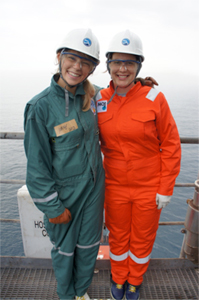
Microbiologist Elizabeth Trembath-Reichert (Caltech) and myself on top of the derrick.


Deep Fe and microbes unknownAugust 3, 2012
Hello everyone!! Tomoyuki Hori from AIST present today’s report. In this cruise, I am trying to cultivate as-yet-unknown microbes living in the deep sediment. It has been unveiled that numerous microbial lives exist in the Shimokita subseafloor. However, little is known why these microbes can survive under the energy-limited environment. I hypothesize that the buried ferric iron minerals may be very important for the energy respiration. Iron is the fourth most abundant element in the earth’s crust, and in particular, the coast of Hachinohe and northern Honshu area in Japan has been famous for iron production (e.g., Japanese Samurai sword, temple ring). For instance, sand on the Tanesashi shore in Hachinohe city looks blackish, perhaps due to may iron like manganese. This shore has long history as a production area of good-quality iron sand in Japan. In this cruise, I look forward to seeing the 2 km-deep terrestrial deposit that may contain large amounts of iron. What is hidden relationship between deep life and iron minerals? I try to figure out this puzzle using new cultivation method with highly crystalline iron oxides as microbial energy sources. I am really waiting for the subsurface cores with great motivation.
Today, each research group perseveres in preparing experiments onboard. In parallel with this, "rig tour" was held, in which we visited the huge installation for core drilling such as the blow-out-preventer (BOP), riser pipes, and big engines. Many scientists, including me, are the first experience of Chikyu, so we enjoyed it very much. The picture was taken in so called “Driller’s House”, in which drillers control all the mechanical drilling process, seems one of the most special places in Chikyu. A smiled person on the seat for drillers is, actually, ME ! It was my precious experience in my life. We scientists thank ship crew very much for the kind guidance and their hard work. Expedition 337 is now ongoing by the big support of all ship crew. I appreciate them and do my best to achieve our scientific goals.
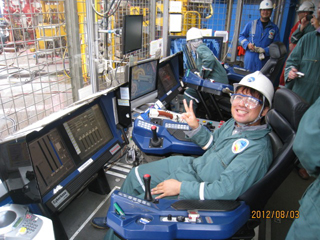


Impressions from the ChikyuAugust 2, 2012
I went for a walk on the helicopter deck and core cutting area this evening with co-chief scientist Fumio Inagaki, and European geochemist Clemens Glombitza. It was a warm, foggy night. We were completely taken by the magnitude of the operations on the Chikyu. The moon pool, a hole-like open area in the middle of the ship, where the drill and drill pipe pass through on their way under the seafloor, has the dimensions of a decent-sized swimming pool. The cranes on deck are the size of ones in container ports, and look like they can reach to the top of the drill tower at 130 m. Everything on deck looks too large to be true - almost fake - until the next monstrous robot or crane moves the next pipe with ease and speed. One then realizes that it is ones own minuteness and inability to grasp things much larger than one is used to seeing that give rise to the delusion of falsehood.
In a few days, the drilling operators are expecting to lift the blow-out-preventer (BOP) - a huge valve that weighs 380 tons and will be lowered to the borehole at the bottom of the seafloor. The fact that it serves to prevent potentially catastrophic releases of gas from the seabed is another reminder that drilling into the subseafloor is a serious, and extremely advanced technological endeavor, even though it at times looks like plastic toys in action.
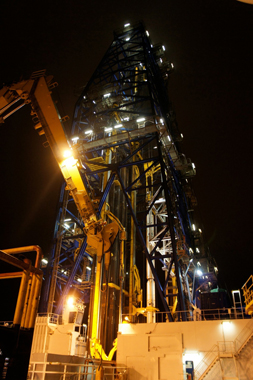


Scientists onboard Chikyu by helicopterJuly 31, 2012
The shipboard scientists of Expedition 337 from world nations finally met together in Hachinohe. We enjoyed extremely fresh local seafood and some nice Japanese beer/sake last night, and talked many things about the future dream or family. Chikyu is a complete "dry" ship, so we are NOT allowed to drink alcohols on Chikyu for 2 months... we thank the warm hospitality of Hachinohe.
The weather on July 31 is fine, almost perfect for the helicopter flight. The helicopter boarding is a kind of exciting events during this expedition since it will be the first time for many shipboard scientists. It seems that many scientists are surprised by the bigness of Chikyu, but more surprises will show up from now on.
On the vessel, preparations for the riser drilling are generally going smoothly, the drilling team have already retrieved the borehole cap and set some transponders. Scientists will have a kick-off meeting today and start preparing many things for the first core sample on deck.
